engine coolant Seat Altea XL 2014 Owner's Manual
[x] Cancel search | Manufacturer: SEAT, Model Year: 2014, Model line: Altea XL, Model: Seat Altea XL 2014Pages: 321, PDF Size: 4.52 MB
Page 6 of 321
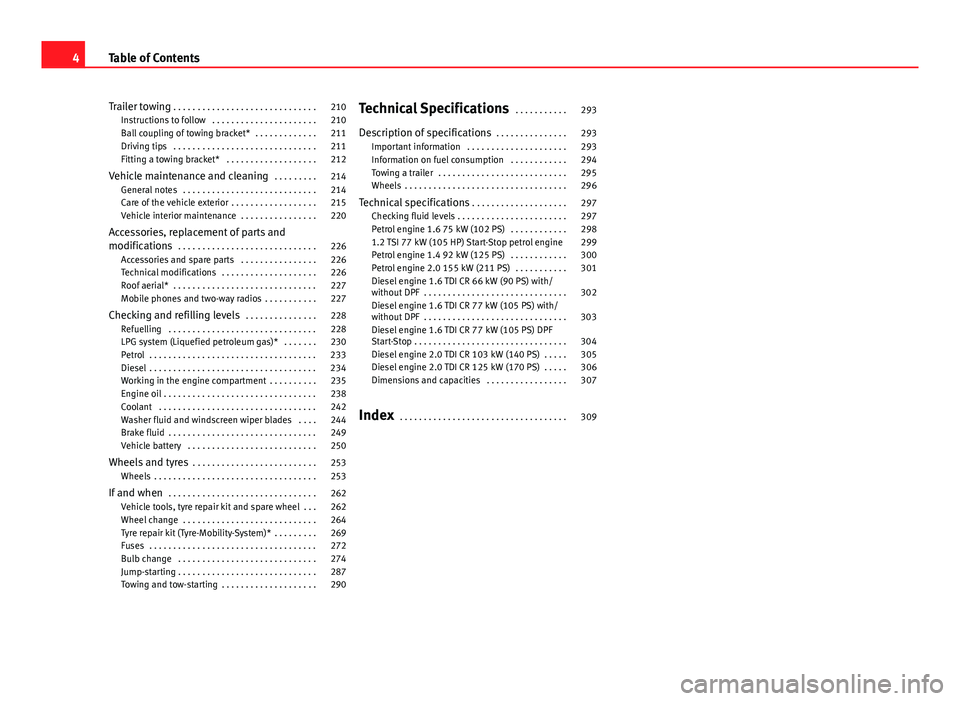
Trailer towing . . . . . . . . . . . . . . . . . . . . . . . . . . . . . . 210
Instructions to follow . . . . . . . . . . . . . . . . . . . . . . 210
Ball coupling of towing bracket* . . . . . . . . . . . . . 211
Driving tips . . . . . . . . . . . . . . . . . . . . . . . . . . . . . . 211
Fitting a towing bracket* . . . . . . . . . . . . . . . . . . . 212
Vehicle maintenance and cleaning . . . . . . . . . 214
General notes . . . . . . . . . . . . . . . . . . . . . . . . . . . . 214
Care of the vehicle exterior . . . . . . . . . . . . . . . . . . 215
Vehicle interior maintenance . . . . . . . . . . . . . . . . 220
Accessories, replacement of parts and
modifications . . . . . . . . . . . . . . . . . . . . . . . . . . . . . 226
Accessories and spare parts . . . . . . . . . . . . . . . . 226
Technical modifications . . . . . . . . . . . . . . . . . . . . 226
Roof aerial* . . . . . . . . . . . . . . . . . . . . . . . . . . . . . . 227
Mobile phones and two-way radios . . . . . . . . . . . 227
Checking and refilling levels . . . . . . . . . . . . . . . 228
Refuelling . . . . . . . . . . . . . . . . . . . . . . . . . . . . . . . 228
LPG system (Liquefied petroleum gas)* . . . . . . . 230
Petrol . . . . . . . . . . . . . . . . . . . . . . . . . . . . . . . . . . . 233
Diesel . . . . . . . . . . . . . . . . . . . . . . . . . . . . . . . . . . . 234
Working in the engine compartment . . . . . . . . . . 235
Engine oil . . . . . . . . . . . . . . . . . . . . . . . . . . . . . . . . 238
Coolant . . . . . . . . . . . . . . . . . . . . . . . . . . . . . . . . . 242
Washer fluid and windscreen wiper blades . . . . 244
Brake fluid . . . . . . . . . . . . . . . . . . . . . . . . . . . . . . . 249
Vehicle battery . . . . . . . . . . . . . . . . . . . . . . . . . . . 250
Wheels and tyres . . . . . . . . . . . . . . . . . . . . . . . . . . 253
Wheels . . . . . . . . . . . . . . . . . . . . . . . . . . . . . . . . . . 253
If and when . . . . . . . . . . . . . . . . . . . . . . . . . . . . . . . 262
Vehicle tools, tyre repair kit and spare wheel . . . 262
Wheel change . . . . . . . . . . . . . . . . . . . . . . . . . . . . 264
Tyre repair kit (Tyre-Mobility-System)* . . . . . . . . . 269
Fuses . . . . . . . . . . . . . . . . . . . . . . . . . . . . . . . . . . . 272
Bulb change . . . . . . . . . . . . . . . . . . . . . . . . . . . . . 274
Jump-starting . . . . . . . . . . . . . . . . . . . . . . . . . . . . . 287
Towing and tow-starting . . . . . . . . . . . . . . . . . . . . 290 Technical Specifications
. . . . . . . . . . . 293
Description of specifications . . . . . . . . . . . . . . . 293
Important information . . . . . . . . . . . . . . . . . . . . . 293
Information on fuel consumption . . . . . . . . . . . . 294
Towing a trailer . . . . . . . . . . . . . . . . . . . . . . . . . . . 295
Wheels . . . . . . . . . . . . . . . . . . . . . . . . . . . . . . . . . . 296
Technical specifications . . . . . . . . . . . . . . . . . . . . 297
Checking fluid levels . . . . . . . . . . . . . . . . . . . . . . . 297
Petrol engine 1.6 75 kW (102 PS) . . . . . . . . . . . . 298
1.2 TSI 77 kW (105 HP) Start-Stop petrol engine 299
Petrol engine 1.4 92 kW (125 PS) . . . . . . . . . . . . 300
Petrol engine 2.0 155 kW (211 PS) . . . . . . . . . . . 301
Diesel engine 1.6 TDI CR 66 kW (90 PS) with/
without DPF . . . . . . . . . . . . . . . . . . . . . . . . . . . . . . 302
Diesel engine 1.6 TDI CR 77 kW (105 PS) with/
without DPF . . . . . . . . . . . . . . . . . . . . . . . . . . . . . . 303
Diesel engine 1.6 TDI CR 77 kW (105 PS) DPF
Start-Stop . . . . . . . . . . . . . . . . . . . . . . . . . . . . . . . . 304
Diesel engine 2.0 TDI CR 103 kW (140 PS) . . . . . 305
Diesel engine 2.0 TDI CR 125 kW (170 PS) . . . . . 306
Dimensions and capacities . . . . . . . . . . . . . . . . . 307
Index . . . . . . . . . . . . . . . . . . . . . . . . . . . . . . . . . . . 309
4Table of Contents
Page 59 of 321
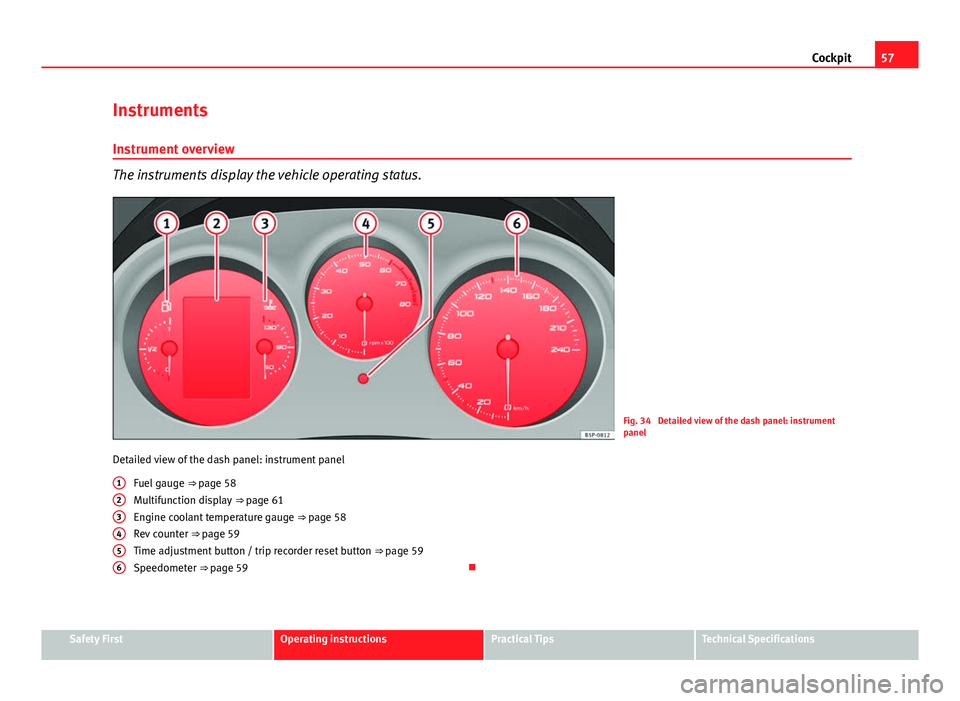
57
Cockpit
Instruments Instrument overview
The instruments display the vehicle operating status.
Fig. 34 Detailed view of the dash panel: instrument
panel
Detailed view of the dash panel: instrument panel Fuel gauge ⇒ page 58
Multifunction display ⇒ page 61
Engine coolant temperature gauge ⇒ page 58
Rev counter ⇒ page 59
Time adjustment button / trip recorder reset button ⇒ page 59
Speedometer ⇒ page 59
1
23456
Safety FirstOperating instructionsPractical TipsTechnical Specifications
Page 60 of 321
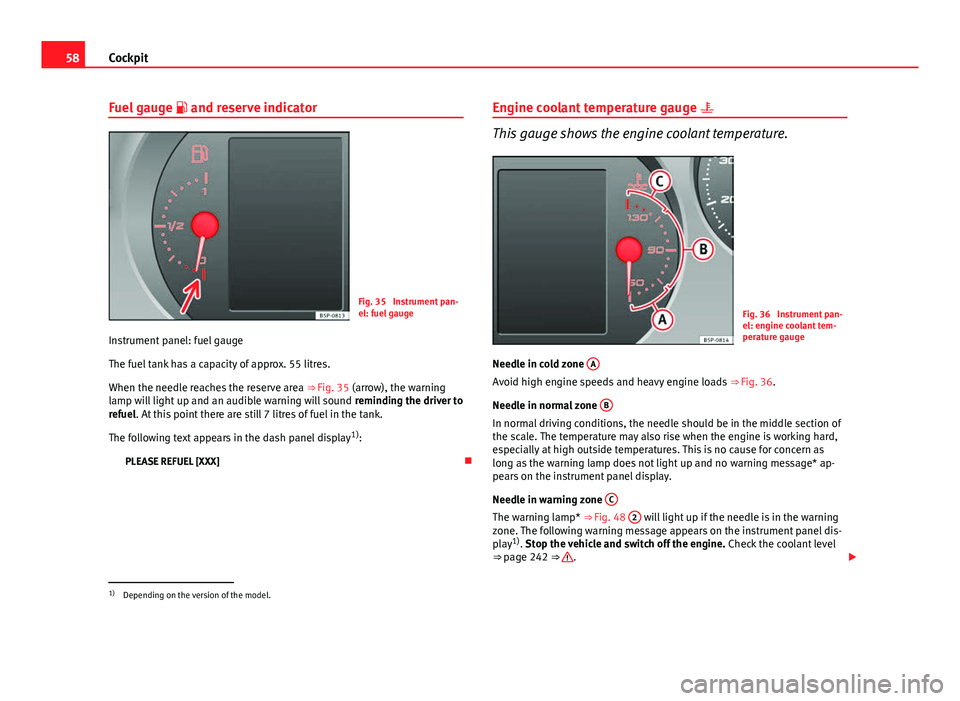
58Cockpit
Fuel gauge and reserve indicator
Fig. 35 Instrument pan-
el: fuel gauge
Instrument panel: fuel gauge
The fuel tank has a capacity of approx. 55 litres.
When the needle reaches the reserve area ⇒ Fig. 35 (arrow), the warning
lamp will light up and an audible warning will sound reminding the driver to
refuel. At this point there are still 7 litres of fuel in the tank.
The following text appears in the dash panel display 1)
:
PLEASE REFUEL [XXX] Engine coolant temperature gauge
This gauge shows the engine coolant temperature.
Fig. 36 Instrument pan-
el: engine coolant tem-
perature gauge
Needle in cold zone A
Avoid high engine speeds and heavy engine loads
⇒ Fig. 36.
Needle in normal zone B
In normal driving conditions, the needle should be in the middle section of
the scale. The temperature may also rise when the engine is working hard,
especially at high outside temperatures. This is no cause for concern as
long as the warning lamp does not light up and no warning message* ap-
pears on the instrument panel display.
Needle in warning zone C
The warning lamp* ⇒ Fig. 48 2 will light up if the needle is in the warning
zone. The following warning message appears on the instrument panel dis-
play 1)
. Stop the vehicle and switch off the engine. Check the coolant level
⇒ page 242 ⇒
.
1)
Depending on the version of the model.
Page 61 of 321
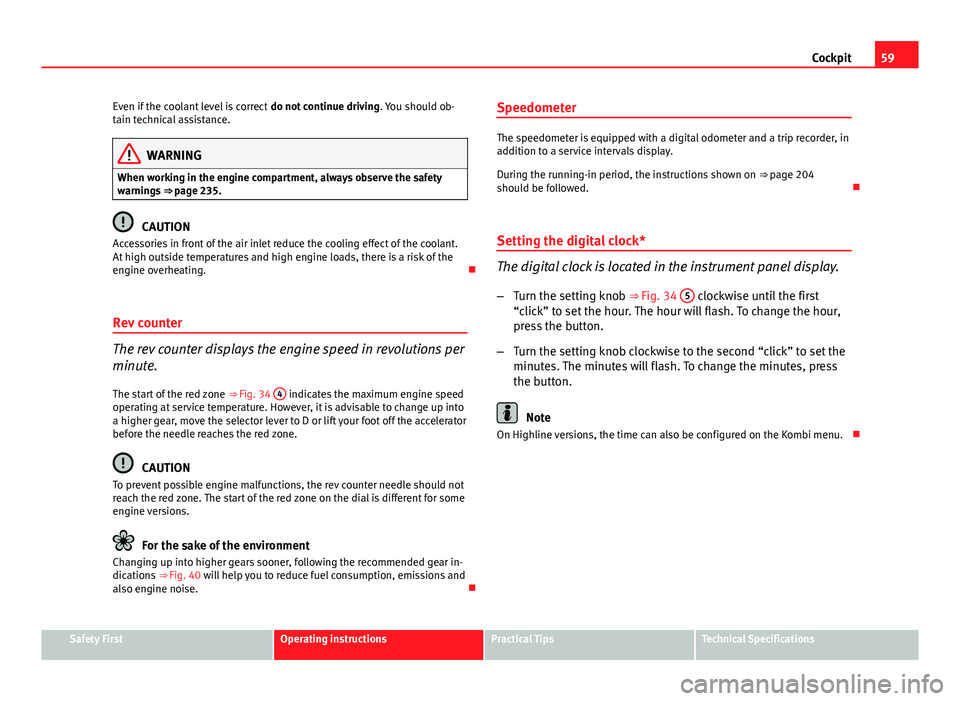
59
Cockpit
Even if the coolant level is correct do not continue driving. You should ob-
tain technical assistance.
WARNING
When working in the engine compartment, always observe the safety
warnings ⇒ page 235.
CAUTION
Accessories in front of the air inlet reduce the cooling effect of the coolant.
At high outside temperatures and high engine loads, there is a risk of the
engine overheating.
Rev counter
The rev counter displays the engine speed in revolutions per
minute. The start of the red zone ⇒ Fig. 34 4
indicates the maximum engine speed
operating at service temperature. However, it is advisable to change up into
a higher gear, move the selector lever to D or lift your foot off the accelerator
before the needle reaches the red zone.
CAUTION
To prevent possible engine malfunctions, the rev counter needle should not
reach the red zone. The start of the red zone on the dial is different for some
engine versions.
For the sake of the environment
Changing up into higher gears sooner, following the recommended gear in-
dications ⇒ Fig. 40 will help you to reduce fuel consumption, emissions and
also engine noise. Speedometer
The speedometer is equipped with a digital odometer and a trip recorder, in
addition to a service intervals display.
During the running-in period, the instructions shown on
⇒ page 204
should be followed.
Setting the digital clock*
The digital clock is located in the instrument panel display.
– Turn the setting knob ⇒ Fig. 34 5
clockwise until the first
“click” to set the hour. The hour will flash. To change the hour,
press the button.
– Turn the setting knob clockwise to the second “click” to set the
minutes. The minutes will flash. To change the minutes, press
the button.
Note
On Highline versions, the time can also be configured on the Kombi menu.
Safety FirstOperating instructionsPractical TipsTechnical Specifications
Page 68 of 321
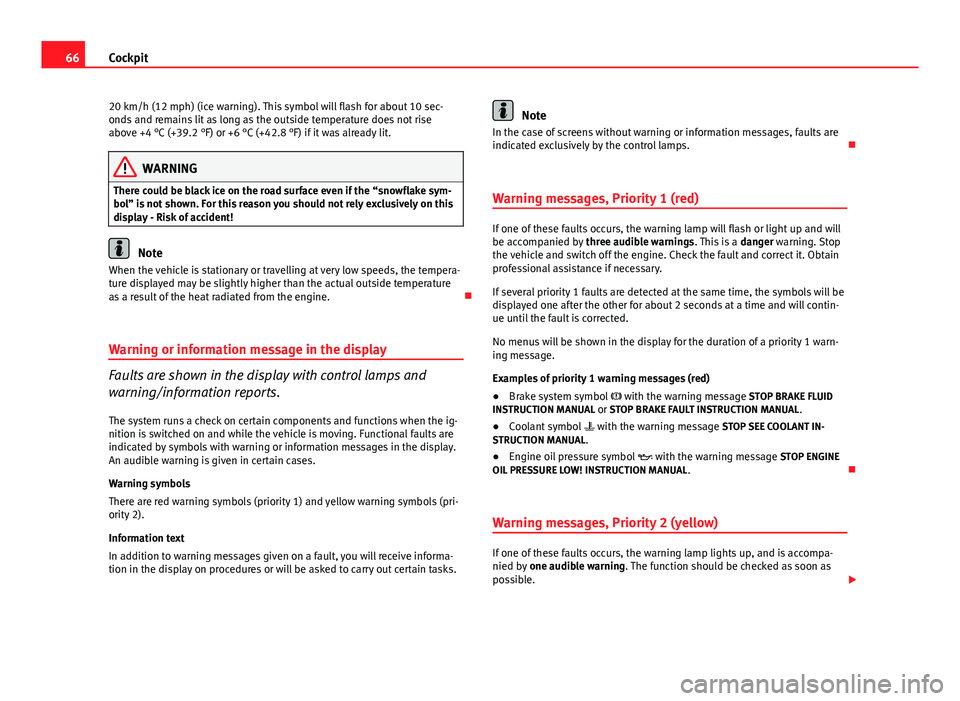
66Cockpit
20 km/h (12 mph) (ice warning). This symbol will flash for about 10 sec-
onds and remains lit as long as the outside temperature does not rise
above +4 °C (+39.2 °F) or +6 °C (+42.8 °F) if it was already lit.
WARNING
There could be black ice on the road surface even if the “snowflake sym-
bol” is not shown. For this reason you should not rely exclusively on this
display - Risk of accident!
Note
When the vehicle is stationary or travelling at very low speeds, the tempera-
ture displayed may be slightly higher than the actual outside temperature
as a result of the heat radiated from the engine.
Warning or information message in the display
Faults are shown in the display with control lamps and
warning/information reports.
The system runs a check on certain components and functions when the ig-
nition is switched on and while the vehicle is moving. Functional faults are
indicated by symbols with warning or information messages in the display.
An audible warning is given in certain cases.
Warning symbols
There are red warning symbols (priority 1) and yellow warning symbols (pri-
ority 2).
Information text
In addition to warning messages given on a fault, you will receive informa-
tion in the display on procedures or will be asked to carry out certain tasks.
Note
In the case of screens without warning or information messages, faults are
indicated exclusively by the control lamps.
Warning messages, Priority 1 (red)
If one of these faults occurs, the warning lamp will flash or light up and will
be accompanied by three audible warnings. This is a danger warning. Stop
the vehicle and switch off the engine. Check the fault and correct it. Obtain
professional assistance if necessary.
If several priority 1 faults are detected at the same time, the symbols will be
displayed one after the other for about 2 seconds at a time and will contin-
ue until the fault is corrected.
No menus will be shown in the display for the duration of a priority 1 warn-
ing message.
Examples of priority 1 warning messages (red)
● Brake system symbol with the warning message STOP BRAKE FLUID
INSTRUCTION MANUAL or STOP BRAKE FAULT INSTRUCTION MANUAL .
● Coolant symbol with the warning message STOP SEE COOLANT IN-
STRUCTION MANUAL.
● Engine oil pressure symbol with the warning message STOP ENGINE
OIL PRESSURE LOW! INSTRUCTION MANUAL .
Warning messages, Priority 2 (yellow)
If one of these faults occurs, the warning lamp lights up, and is accompa-
nied by one audible warning. The function should be checked as soon as
possible.
Page 79 of 321
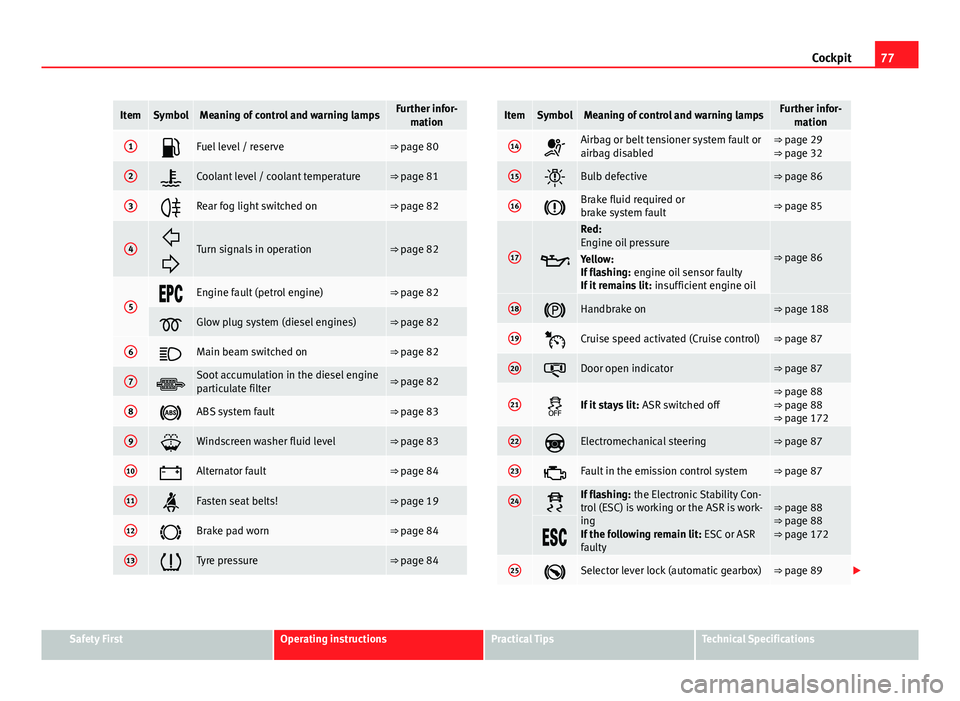
77
Cockpit
ItemSymbolMeaning of control and warning lampsFurther infor-
mation
1Fuel level / reserve⇒ page 80
2Coolant level / coolant temperature⇒ page 81
3Rear fog light switched on⇒ page 82
4
Turn signals in operation⇒ page 82
5Engine fault (petrol engine)⇒ page 82
Glow plug system (diesel engines)⇒ page 82
6Main beam switched on⇒ page 82
7Soot accumulation in the diesel engine
particulate filter⇒ page 82
8ABS system fault⇒ page 83
9Windscreen washer fluid level⇒ page 83
10Alternator fault⇒ page 84
11Fasten seat belts!⇒ page 19
12Brake pad worn⇒ page 84
13Tyre pressure⇒ page 84
ItemSymbolMeaning of control and warning lampsFurther infor- mation
14Airbag or belt tensioner system fault or
airbag disabled⇒ page 29
⇒ page 32
15Bulb defective⇒ page 86
16Brake fluid required or
brake system fault⇒ page 85
17
Red:
Engine oil pressure
⇒ page 86Yellow:
If flashing: engine oil sensor faulty
If it remains lit: insufficient engine oil
18Handbrake on⇒ page 188
19Cruise speed activated (Cruise control)⇒ page 87
20Door open indicator⇒ page 87
21If it stays lit: ASR switched off⇒ page 88
⇒ page 88
⇒ page 172
22Electromechanical steering⇒ page 87
23Fault in the emission control system⇒ page 87
24If flashing: the Electronic Stability Con-
trol (ESC) is working or the ASR is work-
ing
If the following remain lit: ESC or ASR
faulty⇒ page 88
⇒ page 88
⇒ page 172
25Selector lever lock (automatic gearbox)⇒ page 89
Safety FirstOperating instructionsPractical TipsTechnical Specifications
Page 80 of 321
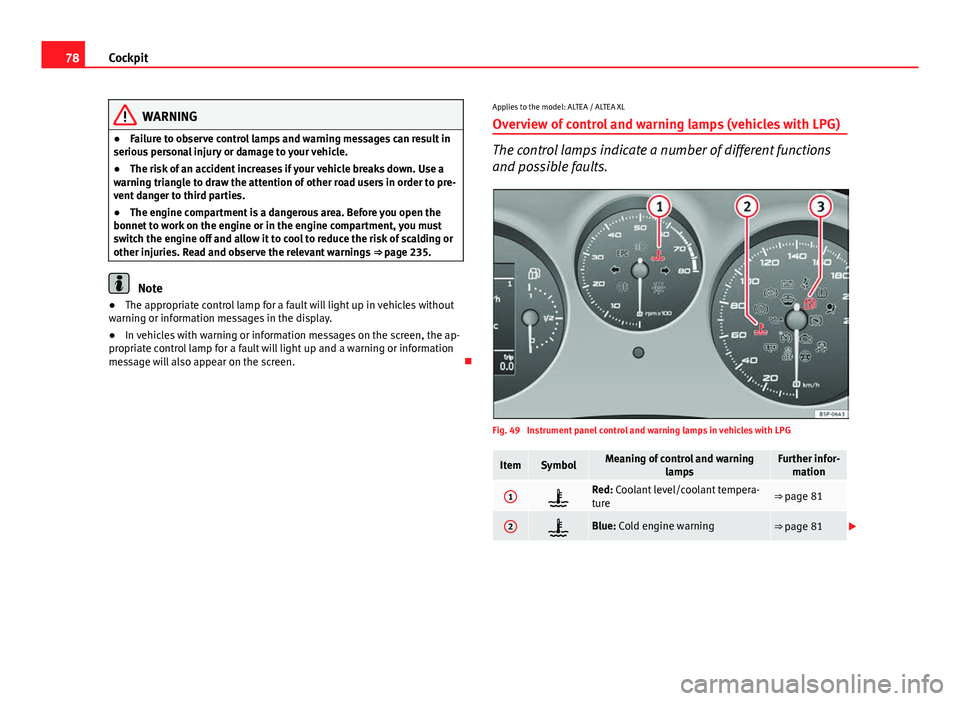
78Cockpit
WARNING
● Failure to observe control lamps and warning messages can result in
serious personal injury or damage to your vehicle.
● The risk of an accident increases if your vehicle breaks down. Use a
warning triangle to draw the attention of other road users in order to pre-
vent danger to third parties.
● The engine compartment is a dangerous area. Before you open the
bonnet to work on the engine or in the engine compartment, you must
switch the engine off and allow it to cool to reduce the risk of scalding or
other injuries. Read and observe the relevant warnings ⇒ page 235.
Note
● The appropriate control lamp for a fault will light up in vehicles without
warning or information messages in the display.
● In vehicles with warning or information messages on the screen, the ap-
propriate control lamp for a fault will light up and a warning or information
message will also appear on the screen. Applies to the model: ALTEA / ALTEA XL
Overview of control and warning lamps (vehicles with LPG)
The control lamps indicate a number of different functions
and possible faults.
Fig. 49 Instrument panel control and warning lamps in vehicles with LPG
ItemSymbolMeaning of control and warning lampsFurther infor-mation
1Red: Coolant level/coolant tempera-
ture⇒ page 81
2Blue: Cold engine warning⇒ page 81
Page 81 of 321
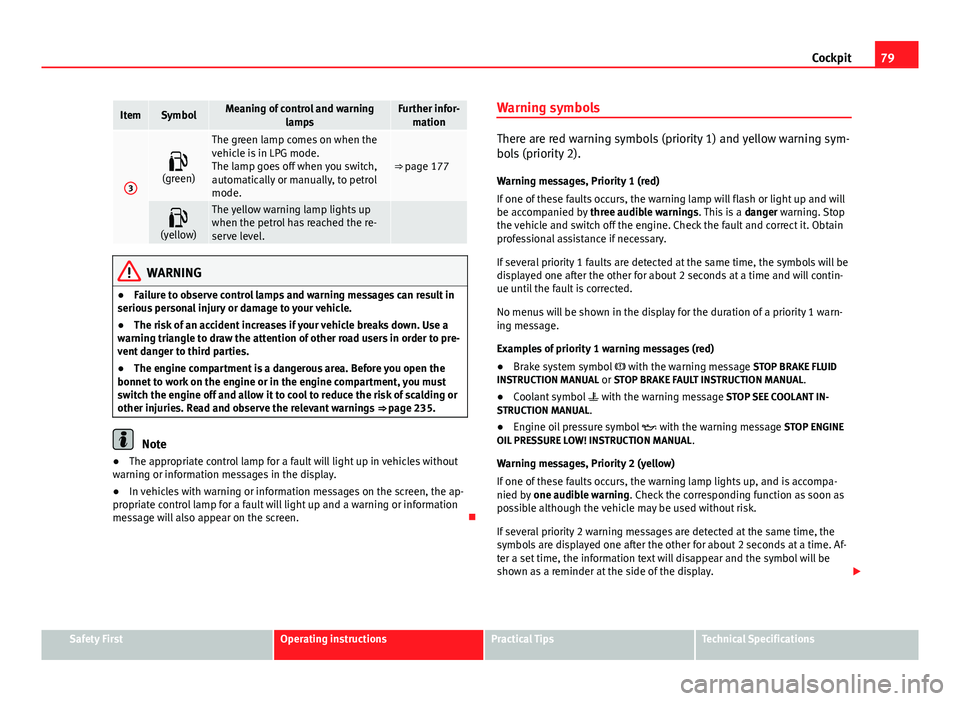
79
Cockpit
ItemSymbolMeaning of control and warning
lampsFurther infor-mation
3
(green)
The green lamp comes on when the
vehicle is in LPG mode.
The lamp goes off when you switch,
automatically or manually, to petrol
mode.
⇒ page 177
(yellow)The yellow warning lamp lights up
when the petrol has reached the re-
serve level.
WARNING
● Failure to observe control lamps and warning messages can result in
serious personal injury or damage to your vehicle.
● The risk of an accident increases if your vehicle breaks down. Use a
warning triangle to draw the attention of other road users in order to pre-
vent danger to third parties.
● The engine compartment is a dangerous area. Before you open the
bonnet to work on the engine or in the engine compartment, you must
switch the engine off and allow it to cool to reduce the risk of scalding or
other injuries. Read and observe the relevant warnings ⇒ page 235.
Note
● The appropriate control lamp for a fault will light up in vehicles without
warning or information messages in the display.
● In vehicles with warning or information messages on the screen, the ap-
propriate control lamp for a fault will light up and a warning or information
message will also appear on the screen. Warning symbols
There are red warning symbols (priority 1) and yellow warning sym-
bols (priority 2).
Warning messages, Priority 1 (red)
If one of these faults occurs, the warning lamp will flash or light up and will
be accompanied by three audible warnings. This is a danger warning. Stop
the vehicle and switch off the engine. Check the fault and correct it. Obtain
professional assistance if necessary.
If several priority 1 faults are detected at the same time, the symbols will be
displayed one after the other for about 2 seconds at a time and will contin-
ue until the fault is corrected.
No menus will be shown in the display for the duration of a priority 1 warn-
ing message.
Examples of priority 1 warning messages (red)
● Brake system symbol with the warning message STOP BRAKE FLUID
INSTRUCTION MANUAL or STOP BRAKE FAULT INSTRUCTION MANUAL .
● Coolant symbol with the warning message STOP SEE COOLANT IN-
STRUCTION MANUAL.
● Engine oil pressure symbol with the warning message STOP ENGINE
OIL PRESSURE LOW! INSTRUCTION MANUAL .
Warning messages, Priority 2 (yellow)
If one of these faults occurs, the warning lamp lights up, and is accompa-
nied by one audible warning. Check the corresponding function as soon as
possible although the vehicle may be used without risk.
If several priority 2 warning messages are detected at the same time, the
symbols are displayed one after the other for about 2 seconds at a time. Af-
ter a set time, the information text will disappear and the symbol will be
shown as a reminder at the side of the display.
Safety FirstOperating instructionsPractical TipsTechnical Specifications
Page 83 of 321
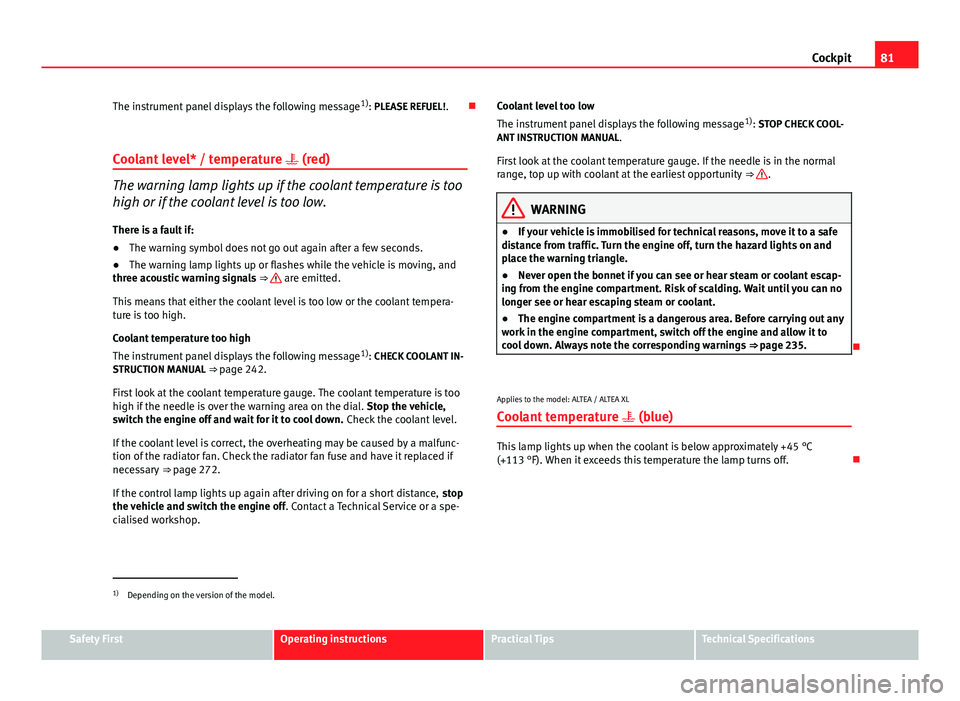
81
Cockpit
The instrument panel displays the following message 1)
: PLEASE REFUEL! .
Coolant level* / temperature (red)
The warning lamp lights up if the coolant temperature is too
high or if the coolant level is too low.
There is a fault if:
● The warning symbol does not go out again after a few seconds.
● The warning lamp lights up or flashes while the vehicle is moving, and
three acoustic warning signals ⇒
are emitted.
This means that either the coolant level is too low or the coolant tempera-
ture is too high.
Coolant temperature too high
The instrument panel displays the following message 1)
: CHECK COOLANT IN-
STRUCTION MANUAL ⇒ page 242.
First look at the coolant temperature gauge. The coolant temperature is too
high if the needle is over the warning area on the dial. Stop the vehicle,
switch the engine off and wait for it to cool down. Check the coolant level.
If the coolant level is correct, the overheating may be caused by a malfunc-
tion of the radiator fan. Check the radiator fan fuse and have it replaced if
necessary ⇒ page 272.
If the control lamp lights up again after driving on for a short distance, stop
the vehicle and switch the engine off . Contact a Technical Service or a spe-
cialised workshop. Coolant level too low
The instrument panel displays the following message
1)
: STOP CHECK COOL-
ANT INSTRUCTION MANUAL.
First look at the coolant temperature gauge. If the needle is in the normal
range, top up with coolant at the earliest opportunity ⇒
.
WARNING
● If your vehicle is immobilised for technical reasons, move it to a safe
distance from traffic. Turn the engine off, turn the hazard lights on and
place the warning triangle.
● Never open the bonnet if you can see or hear steam or coolant escap-
ing from the engine compartment. Risk of scalding. Wait until you can no
longer see or hear escaping steam or coolant.
● The engine compartment is a dangerous area. Before carrying out any
work in the engine compartment, switch off the engine and allow it to
cool down. Always note the corresponding warnings ⇒ page 235.
Applies to the model: ALTEA / ALTEA XL Coolant temperature (blue)
This lamp lights up when the coolant is below approximately +45 °C
(+113 °F). When it exceeds this temperature the lamp turns off.
1)
Depending on the version of the model.
Safety FirstOperating instructionsPractical TipsTechnical Specifications
Page 165 of 321
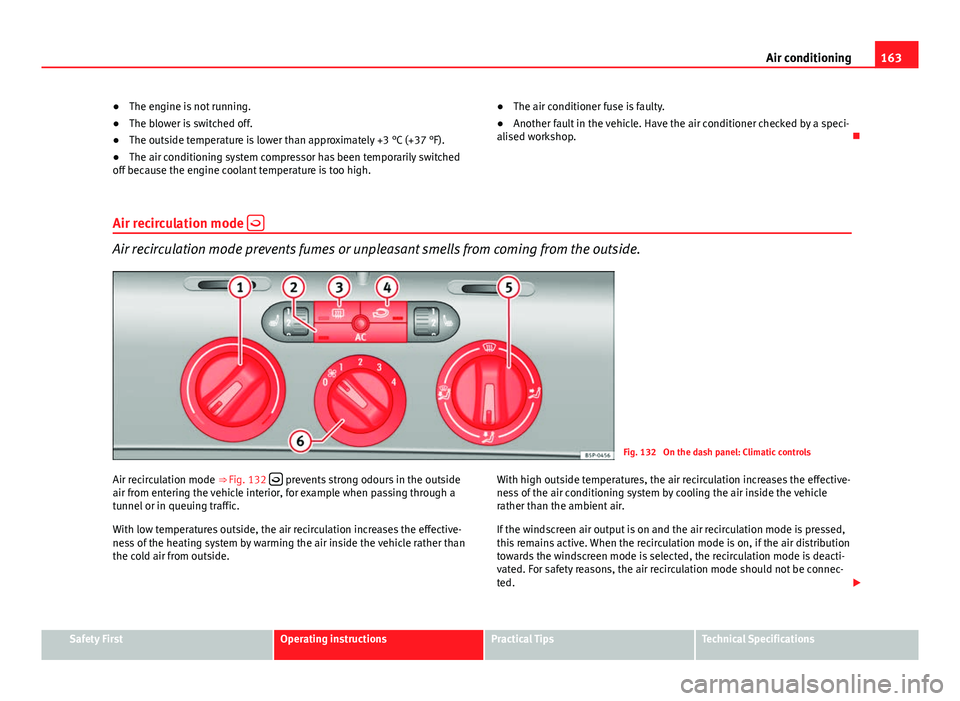
163
Air conditioning
● The engine is not running.
● The blower is switched off.
● The outside temperature is lower than approximately +3 °C (+37 °F).
● The air conditioning system compressor has been temporarily switched
off because the engine coolant temperature is too high. ●
The air conditioner fuse is faulty.
● Another fault in the vehicle. Have the air conditioner checked by a speci-
alised workshop.
Air recirculation mode
Air recirculation mode prevents fumes or unpleasant smells from coming from the outside.
Fig. 132 On the dash panel: Climatic controls
Air recirculation mode ⇒ Fig. 132
prevents strong odours in the outside
air from entering the vehicle interior, for example when passing through a
tunnel or in queuing traffic.
With low temperatures outside, the air recirculation increases the effective-
ness of the heating system by warming the air inside the vehicle rather than
the cold air from outside. With high outside temperatures, the air recirculation increases the effective-
ness of the air conditioning system by cooling the air inside the vehicle
rather than the ambient air.
If the windscreen air output is on and the air recirculation mode is pressed,
this remains active. When the recirculation mode is on, if the air distribution
towards the windscreen mode is selected, the recirculation mode is deacti-
vated. For safety reasons, the air recirculation mode should not be connec-
ted.
Safety FirstOperating instructionsPractical TipsTechnical Specifications